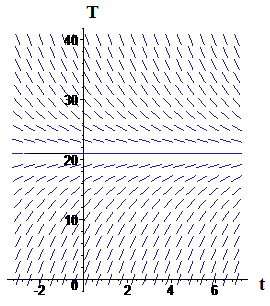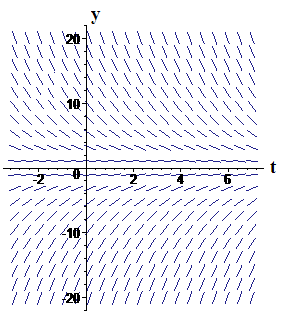Chapter 3
Initial Value Problems
3.2 An Initial Value Problem: A Cooling Body
3.2.3 Solving the Initial Value Problem Symbolically
Now that we have seen a graphical interpretation of the solution of the initial value problem, we'll find a symbolic representation. Our differential equation for temperature of the cooling body is not exactly like the problems considered in Chapter 2 because the rate of change is proportional to , not to . That observation is what suggests the proposed change of dependent variable to . Now
Thus, by substituting and into the original differential equation, we get a differential equation for the new unknown function `y`:
Also, at , , so , which gives us an initial condition for the unknown function `y`. Thus, the substitution transforms the original initial value problem to a new initial value problem:
We illustrate the transformation from `T` to `y` in Figures 1 and 2. Figure 1 shows a slope field for the original differential equation. In Figure 2 we show the effect of the change of dependent variable, , which is to move the horizontal axis from to the level of room temperature, or . None of the slopes change because, at each value of `t`, . Notice that the point `text[(]0,9text[)]` in Figure 2 corresponds to the point `text[(]0,30text[)]` in Figure 1.
 |
 |
|
| Figure 1 Slope field for | Figure 2 Effect of substituting |
Our new initial value problem,
should look familiar: It's the natural growth equation — except our growth factor is negative. The problem has exactly the form we saw in Chapter 2,
with . (In form, it is also the problem you studied in Activity 2, Activity 4, and Example 3 in the preceding section.) So the solution must have the form we saw in Chapter 2:
That is
Of course, `y` is not the quantity we wanted to know about — it was merely a computational convenience. But we can reverse the change of the dependent variable by substituting and solving for `T`:



